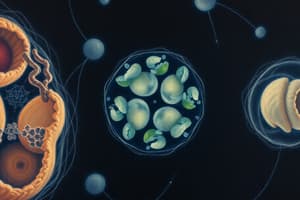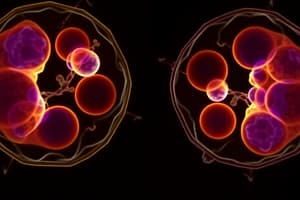Podcast
Questions and Answers
What is the shape of mitochondrial DNA?
What is the shape of mitochondrial DNA?
- None of these
- Double stranded
- Circular (correct)
- Naked
Which of the following cell types contain a cell wall?
Which of the following cell types contain a cell wall?
- Fungal cell
- Animal cell
- Prokaryotic cell
- All of the above (correct)
During which phase are histone proteins synthesized?
During which phase are histone proteins synthesized?
- G1-phase
- S-phase (correct)
- M-phase
- G2-phase
What is the process of synapsis?
What is the process of synapsis?
What is stored in the nucleolus?
What is stored in the nucleolus?
Study Notes
Cell Structures
- Mitochondrial DNA is naked, circular, and double-stranded.
- Cell wall is present in plant cells, prokaryotic cells, and algal cells.
- Plasma membrane is a fluid structure due to the presence of lipids.
- Histone proteins are synthesized during the S-phase of interphase.
- Synapsis is the pairing of homologous chromosomes.
Nucleus and Cell Cycle
- The nucleolus is not covered by a membrane.
- Singer and Nicholson's fluid mosaic model replaced Danielli and Davson's sandwich model because it better explains the dynamic and flexible nature of the plasma membrane.
- Chiasmata are points of crossing over between non-sister chromatids during meiosis.
- The cell cycle is a series of events leading to cell growth and division.
- Interphase is the stage of the cell cycle where cell growth, DNA replication, and organelle duplication occur.
Meiosis
- Leptotene: The chromosomes become visible and appear thread-like.
- Zygotene: Synapsis occurs, where homologous chromosomes pair up.
- Pachytene: Crossing over occurs, where genetic material is exchanged between non-sister chromatids.
- Diplotene: Desynapsis occurs, where homologous chromosomes begin to separate.
- Metaphase (plant cell): The chromosomes are aligned at the equator of the cell, with spindle fibers attached to the centromere.
- Smooth endoplasmic reticulum (SER) is involved in lipid synthesis and detoxification.
- Rough endoplasmic reticulum (RER) is studded with ribosomes and is involved in protein synthesis.
Organelles
- Nucleolus - manufactures ribosomes
- Chloroplast - carries out photosynthesis
- Mitochondria - manufactures ATP in plant and animal cells.
Mitosis vs Meiosis
- Mitosis: Produces diploid cells (two daughter cells with the same number of chromosomes as the parent cell), occurs in somatic cells, and involves one round of cell division.
- Meiosis: Produces haploid cells (four daughter cells with half the number of chromosomes as the parent cell), occurs in germ cells, and involves two rounds of cell division.
Studying That Suits You
Use AI to generate personalized quizzes and flashcards to suit your learning preferences.
Related Documents
Description
Test your knowledge on cell structures, the cell cycle, and meiosis. This quiz covers key concepts such as mitochondrial DNA, plasma membrane structure, and the stages of meiosis. Perfect for students studying biology and cell science.




